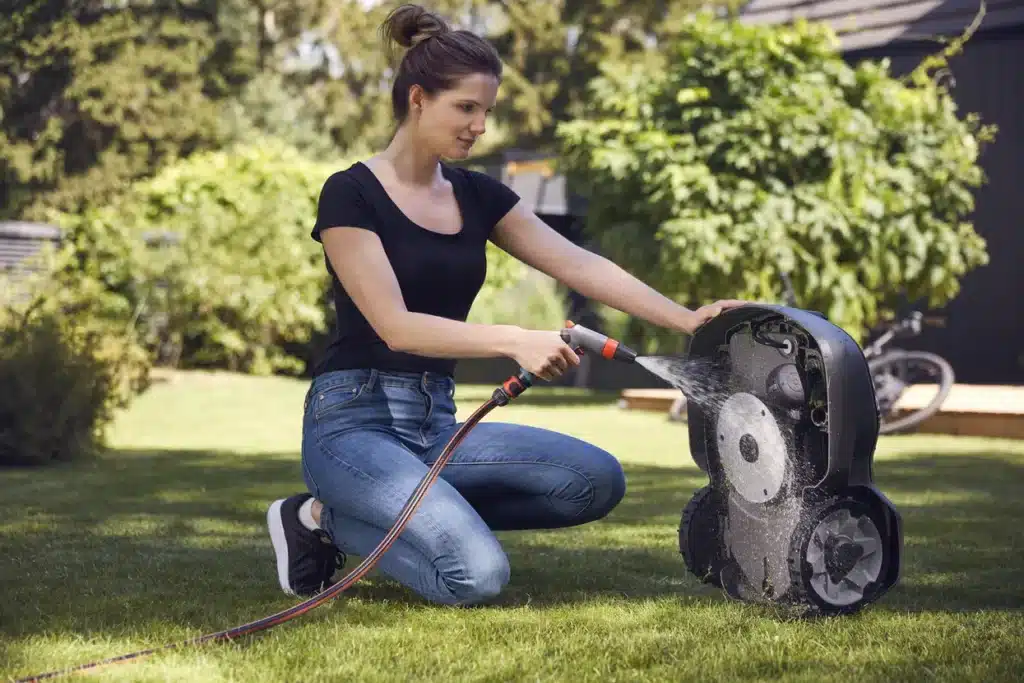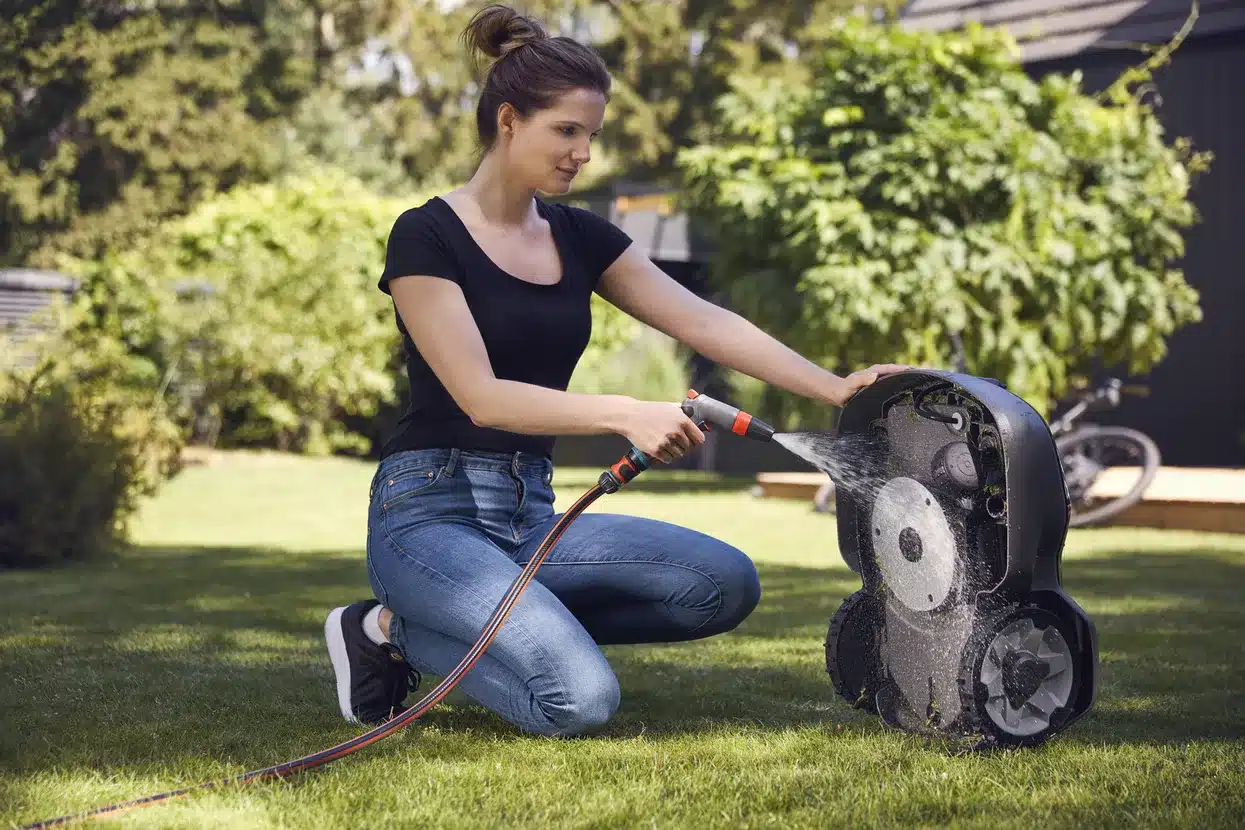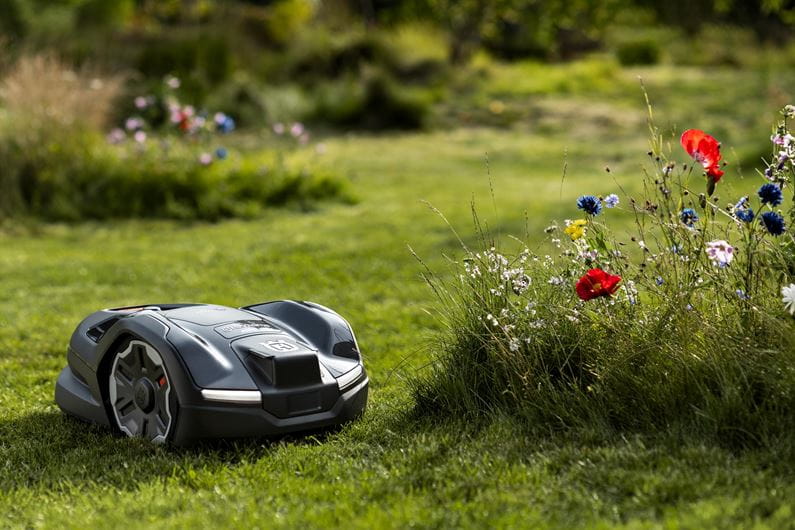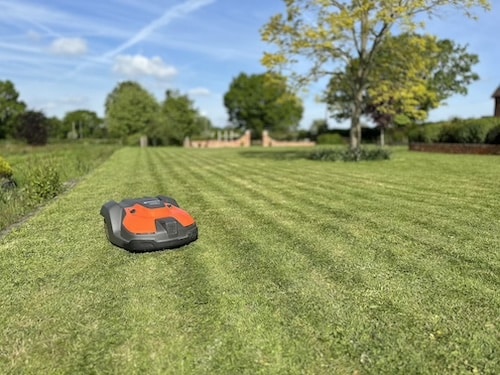Here you can find all the basics when it comes to buying, installing and running your robotic lawnmower.

A robotic lawnmower is a device that uses sensors and algorithms to navigate and mow a lawn automatically. It is designed to operate independently without human intervention.
A robotic lawnmower uses GPS or boundary wire to map out the area it is supposed to mow. It then uses sensors to navigate around obstacles, and algorithms to determine the most efficient mowing pattern. It mows, parks, and charges all by itself.
There are robot lawn mowers with no wire needed. You can buy Husqvarna 450x Nera which uses EPOS technology rather than a perimeter wire in the ground. There are a number of benefits to this such as flexibility of the installation and no risk of cable breaks.
Yes, most robotic lawnmowers can be programmed to mow at specific times of the day or week. Best practice is to mow little and often which requires the mower to be out cutting at least 3 or 4 days a week, if not more. You can set and change the schedule via the app or on the mower itself.
Robotic lawnmowers are designed with safety features, including sensors that can detect obstacles and stop the mower from moving in a dangerous direction. They are also designed to shut off if lifted, so they cannot cause injury. The blades are small and spin independently so if they hit any hard object they will fold in and safely leave the object intact.
The cost of a robotic lawnmower can range from a few hundred pounds to 5 or 6 thousand pounds, depending on the model and features. With robot mower technology you get what you pay for, so something which should last approximately 10 years, it is advisable to invest in one which is over £800 so you have something that is well built.
The lifespan of a robotic lawnmower can vary depending on the model and how well it is maintained. On average, a robotic lawnmower can last for 5-10 years. With some repairs and replacement parts it is not unusual for a robot mower to last 12 or more years.
Most robotic lawnmowers can handle moderately uneven terrain, but some models are designed specifically for more challenging landscapes, such as the Husqvarna 435X which is all-wheel-drive.
Some robotic lawnmowers can handle moderate slopes, but it’s important to check the specifications of the model you are considering. Gentle slopes less than 24 degrees can usually be managed by 2-wheel drive machines, whereas on steeper slopes an all-wheel-drive is recommended.
Robotic lawnmowers can be used in a garden with a pond, but it’s important to ensure that they do not fall into the pond, with correct installation required. Moisture and electronic components do not mix!
Robotic lawnmowers use sensors to detect flower beds and other landscaping features, and can be programmed to avoid them either using wire or GPS settings.
Robot mowers can be installed by yourself but for invisible wires, peace of mind and support, it is best to purchase your mower and have it installed by the same company. Install right and install once is best in ensuring your mower works without headaches. So it worth paying a little more to have it installed by experts with excellent knowledge and experience of robot mowers.
If your robot mower is installed by a professional, then usually installation should take no more than one day. If you are installing yourself and the lawn is quite small, then it could be done in only a few hours, however, it is better for the wire to be buried rather than peg to the surface. On medium to large installations, it could take days if not weeks without the use of the correct equipment used by a robotic mower professional.
Most robotic lawnmowers are designed to operate in normal weather conditions, but some models may be able to handle extreme conditions. However, it is not good for the lawn to mow when frosty as it can result in disease. Some robotic lawnmowers have frost guard which detects when the temperature is low and therefore automatically parks itself.
Most robotic lawnmowers are designed for lawns between 100sqm and 5000sqm, which is 1.25 acres is size. There are models available that can handle larger areas and costs are proportionate to the size of the area it can cover.
Yes, robotic lawnmowers can be used on commercial properties, but it’s important to select a model that is designed for commercial use. Robot mowers can significantly reduce ongoing labour costs while also helping businesses reach net zero.
Robotic lawnmowers can handle uneven lawn height by adjusting the cutting height either via the mower or the app. Because robot mowers cut at a perfectly even height, it is best practice to set the height to match the length of the longest blade of grass and gradually reduce over 5-10 days until you reach the desired height.
There are many different robot mowers on the market and every garden is different, therefore you should speak to one of our team who will provide you with a free garden survey and full quote to advise you which is the best suited mower for your lawn.
There are some robot mowers that do stripes. Such as the Husqvarna 550 EPOS and the Kress Mission Mega RTKn. These robotic lawnmowers mow stripes by systematically covering the lawn using RTK technology which mows stripes on your lawn with centimetre accuracy. With some automatic mowers you can also change the pattern/stripe direction.
Robotic lawnmowers are much quieter than traditional lawn mowers, with noise levels ranging from 50 to 70 decibels.
Avoid using too much water. Some robot mowers allow for use of hosepipe but it is best to avoid the body seals or anywhere water could penetrate as water does not mix well with electronic components! You can use a dry brush and a damp cloth, mixed with active cleaning detergent designed for plastics and vehicles. As long as the moving parts are free from obstruction, a lot of the dirt is superficial on a robot mower as it is designed to be outside and will often become dirty with use. Winter servicing is useful as a full clean can be provided, including hoovering inside and replacing body seals.
Most robotic lawnmowers can handle different types of grass, but with particularly coarse grass most mowers are best set to a medium rather than short height.
Robotic lawnmowers are designed to cut grass, but sometimes it is necessary for the robot mower to pass from one area of lawn to the next, requiring it to operate on different types of services, for example, gravel driveway, brick pathway, or even a bridge across a river, separating two lawns.
Some robotic lawnmowers use sensors to detect obstacles and avoid them, but generally speaking they are designed to lightly bounce off objects such as trees or washing lines.
Robotic lawnmowers will mow and mulch pet waste, along with lawn clippings and other organic matter, but it’s still useful to clean up pet waste.
Robotic lawnmowers can handle a large number of trees by using sensors to navigate around them, but some models may require more space to maneuver than others. Obstacle sensors, whilst a nice feature aren’t actually necessary as robot mowers are designed to gently bounce off objects, leaving less strimming needed too.
The charging time for a robotic lawnmower can vary depending on the model and battery capacity. On average, it can take anywhere from 30 minutes to 2 hours to fully charge a robotic lawnmower. Charging is autonomous so no human interaction is required.
Some robotic lawnmowers can be operated remotely using a smartphone app. However this is not a requirement as the robot mower will work autonomously regardless of whether it is paired to a phone or not. However, using the app gives peace of mind when on holiday or away from the home so you know the grass will be cut when you return. It also provides you with GPS for security and tracking.
Robotic lawnmowers can handle multiple lawn areas by using GPS or boundary wire to map out the different areas. If they are disconnected then a transport passage or secondary area should be created.
Most robotic lawnmowers are designed to operate at night, given they operate silently, while others are not. It’s important to check the specifications of the model you are considering.
Robotic lawnmowers are not designed to handle snow and ice, and should be stored indoors during the winter months. During the winter months and while the robot mower is not operational you can either cover up the charging station and leave the power on to ensure heat continues to warm the components and keep everything ticking over. Or, alternatively you can bring everything in and wrap the charging station connections up to prevent and wire corrosion.
Over the last decade we have seen an increase in price for most robot mowers. This is due to advances in technology, use of better materials, and the cost to manufacture electrical components. As well as market inflation. However, as robot motors have become more widely available, it is likely that the cost of cheaper models will fall due to more competitors entering the market place, whilst the top of the range models and market leading manufactures will continue to increase.
Most robotic lawnmowers are not designed to trim edges, as a rule we tend to say that robots will mow 98% of the lawn. The last 2% including the edges should be tidied up with a strimmer or edging shears.
Robotic lawnmowers may be serviced annually to ensure they are functioning properly and to replace any worn parts. Small machines which run only a few times a week can be services less often, however robotic mowers which run between 12-24 hours a day we would recommend servicing every winter.
Lorem Ipsum is simply duRobotic lawnmowers can handle narrow spaces by using boundary wire or GPS programming to navigate through the space. As a rule, a passageway should be a minimum of 60cm, but beater performance comes from 1.2-1.5m passageways, varying from model to model. If the area is too narrow the grass could get churned up or the mower stuck. Correct installation is required.mmy text of the printing and typesetting industry. Lorem Ipsum has been the industry’s standard.
Most robotic lawnmowers are designed to handle leaves and debris, but generally speaking leaves will fall quicker than the mower will mulch. If a blade comes into contact with anything other than grass it will fold in to prevent any damage to the mower or the object.
The battery life of a robotic lawnmower can vary depending on the model and usage. On average, most robotic lawnmowers can mow for 1-4.5 hours on a single charge. Batteries tend to last for at least 3 years and sometimes live as long as 6 years.
Most robotic lawnmowers are designed to handle rain, as they are lightweight compared to more traditional lawnmowers. Also, there is no box to clog up. But it’s important to check the specifications of the model you are considering.




